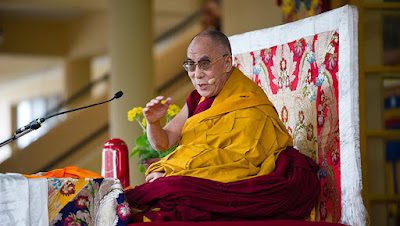Tibetan Exile Group Blasts Chinese Crackdown in Autonomous Region
VOA News: A leading Tibetan exile group says a crackdown by Chinese authorities in the Tibetan Autonomous Region is turning Buddhist monasteries and nunneries from places of worship into facilities dominated by the study of Chinese state propaganda.
Jamphel Monlam, a top official in the Tibetan Center for Human Rights and Democracy, said in an interview with VOA's Tibetan service that Beijing's most recent interference in monastic life includes the clandestine infiltration by security forces into religious facilities, and requirements that monasteries display portraits of Communist Party leaders.
"[The year] 2008 saw a further heightening of controls in major monasteries, where paramilitary forces disguised as firefighting units were stationed in major monasteries, ready to clamp down at any moment and keep close surveillance on monastic activities," he said.
Since then, communist authorities have imposed mass legal education campaigns, Monlam said, which force Buddhist monks and nuns to profess love for the Chinese motherland and to denounce the exiled Tibetan spiritual leader the Dalai Lama.
The widely reported crackdown accelerated last year after a young monk in China's Sichuan province set himself on fire to protest widely perceived Chinese interference in Tibetan life and culture. The monk was also demanding the safe return of the Dalai Lama from exile.
Since then, more than 30 other monks, nuns and their supporters have self-immolated in the region to protest Chinese rule, prompting criticism of the crackdown from a host of Western governments and
human rights organizations.
Monlam, who calls the crackdown "intrusive" and "coercive," said the current Chinese push began 16 years ago.
"China perceives Tibetan monasteries as being their main adversaries and therefore targets for control and coercion starting most recently in 1996 with the 'Love the Nation' campaign which required the denunciation of the Dalai Lama as part of the reeducation program," he said. "It [the crackdown] resulted in the detention and expulsion of hundreds of monks and nuns."
For its part, Beijing calls the Dalai Lama a "splittist" and says the protests against Chinese presence in the Tibetan Autonomous Region are evidence of subversion that will not be tolerated.
The Beijing-controlled website Tibet.cn reported Wednesday on a government-backed meeting in the Tibetan capital last week to discuss the "in-depth legal education campaign" in Tibetan Buddhist temples. The website quoted the local communist governor in Lhasa as saying the push against Tibetan activism is designed to foster "in-depth patriotism, discipline ... and harmony" among locals.
Jamphel Monlam, a top official in the Tibetan Center for Human Rights and Democracy, said in an interview with VOA's Tibetan service that Beijing's most recent interference in monastic life includes the clandestine infiltration by security forces into religious facilities, and requirements that monasteries display portraits of Communist Party leaders.
"[The year] 2008 saw a further heightening of controls in major monasteries, where paramilitary forces disguised as firefighting units were stationed in major monasteries, ready to clamp down at any moment and keep close surveillance on monastic activities," he said.
Since then, communist authorities have imposed mass legal education campaigns, Monlam said, which force Buddhist monks and nuns to profess love for the Chinese motherland and to denounce the exiled Tibetan spiritual leader the Dalai Lama.
The widely reported crackdown accelerated last year after a young monk in China's Sichuan province set himself on fire to protest widely perceived Chinese interference in Tibetan life and culture. The monk was also demanding the safe return of the Dalai Lama from exile.
Since then, more than 30 other monks, nuns and their supporters have self-immolated in the region to protest Chinese rule, prompting criticism of the crackdown from a host of Western governments and
human rights organizations.
Monlam, who calls the crackdown "intrusive" and "coercive," said the current Chinese push began 16 years ago.
"China perceives Tibetan monasteries as being their main adversaries and therefore targets for control and coercion starting most recently in 1996 with the 'Love the Nation' campaign which required the denunciation of the Dalai Lama as part of the reeducation program," he said. "It [the crackdown] resulted in the detention and expulsion of hundreds of monks and nuns."
For its part, Beijing calls the Dalai Lama a "splittist" and says the protests against Chinese presence in the Tibetan Autonomous Region are evidence of subversion that will not be tolerated.
The Beijing-controlled website Tibet.cn reported Wednesday on a government-backed meeting in the Tibetan capital last week to discuss the "in-depth legal education campaign" in Tibetan Buddhist temples. The website quoted the local communist governor in Lhasa as saying the push against Tibetan activism is designed to foster "in-depth patriotism, discipline ... and harmony" among locals.

Comments
Post a Comment